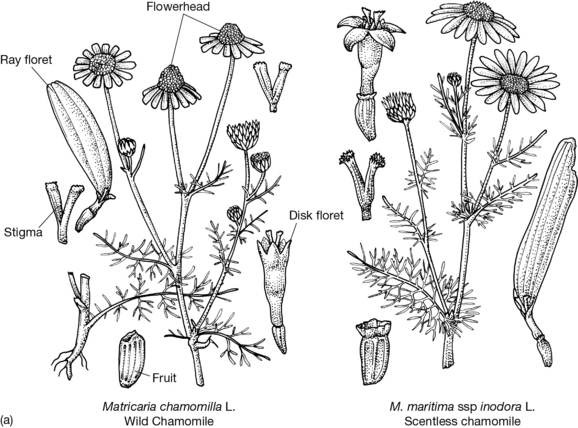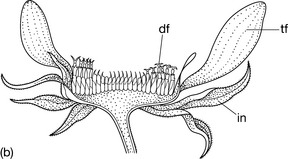Chapter 4 Families yielding important phytopharmaceuticals
Angiosperms (magnoliphyta)
Alliaceae (‘monocotyledoneae’)
Chemical characteristics of the family
The genus Allium is particularly well known for very simple sulphur-containing compounds, especially alliin and allicin (Fig. 4.1), which are thought to be involved in the reported pharmacological activities of the plant as a bactericidal antibiotic, in the treatment of arterial hypertension and in the prevention of arteriosclerosis and stroke.
Apiaceae (also called umbelliferae)
Important medicinal plants in the family (see p. 215-216, Chapter 14)
• Carum carvi L. (caraway), a carminative and also important as a spice
• Coriandrum sativum L. (coriander), a carminative and also important as a spice
• Foeniculum vulgare Miller (fennel), a mild carminative
• Levisticum officinale Koch (lovage), a carminative and antidyspeptic
• Pimpinella anisum L. (anise-fruit, wrongly called ‘seed’), an expectorant, spasmolytic and carminative.
Morphological characteristics of the family
This family of nearly exclusively herbaceous species is characterized by hermaphrodite flowers in a double umbel (Fig. 4.2); note that the closely related Araliaceae have a simple umbel. Typical for the family are the furrowed stems and hollow internodes, leaves with a sheathing base and generally a much divided lamina. The flowers are relatively inconspicuous, with two pistils, an inferior gynaecium with two carpels, a small calyx and generally a white to greenish corolla, with free petals and sepals.
Araliaceae
Important medicinal plants from the family
• Hedera helix L. [(common) ivy], used as a cough remedy
• Panax ginseng C. A. Meyer (ginseng), used as an adaptogene (a very ill-defined category) and to combat mental and physical stress [and sometimes replaced by Eleutherococcus (Acanthopanax) senticosus (Rupr. and Maxim) Maxim from the same family].
Asphodelaceae (‘monocotyledoneae’)
This family is often included in the Liliaceae (lily family).
Asteraceae – the ‘daisy’ family (also known as compositae)
Important medicinal plants from the family
• Arnica montana L. (arnica), used topically, especially for bruises
• Artemisia absinthum L. (wormwood or absinthium), used as a bitter tonic and choleretic
• Calendula officinalis L. (marigold), used topically, especially for some skin afflictions
• Cnicus benedictus L. (cnicus), used as a cholagogue (a bitter aromatic stimulant)
• Cynara scolymus L. (artichoke), used in the treatment of liver and gallbladder complaints and several other conditions
• Echinacea angustifolia DC., E. pallida Nuttall and E. purpurea (L.) Moench (Cone flower), now commonly used as an immunostimulant
• Matricaria recutita L. (chamomille/camomille; several botanical synonyms are also commonly used, including Chamomilla recutita and Matricaria chamomilla) (see Chapter 14, p. 208).
• Tussilago farfara L. (coltsfoot), a now little used expectorant and demulcent.
Chemical characteristics of the family
A typical chemical trait of this family is the presence of polyfructanes (especially inulin) as storage carbohydrates (instead of polysaccharides) in perennial taxa. Inulin-containing drugs are used for preparing malted coffee (e.g. from the rootstocks of Cichorium intybus, chicory). In many taxa, some segments of the family accumulate sesquiterpene lactones (typically with 15-carbon atoms such as parthenolide; Fig. 4.4), which are important natural products responsible for the pharmacological effects of many botanical drugs such as Chrysanthemum parthenium (feverfew) and Arnica montana (arnica). Polyacetylenic compounds (polyenes), and essential oil, are also widely distributed. Some taxa accumulate pyrrolizidine alkaloids, which, for example, are present in Tussilago farfara (coltsfoot) in very small amounts. Many of these alkaloids are known for their hepatotoxic effects. Other taxa accumulate unusual diterpenoids; the diterpene glycoside stevioside (Fig. 4.4), for example, is of interest because of its intensely sweet taste.


Fig. 4.3 (a) Two members of the genus Matricaria. (Left) Matricaria chamomilla L. is aromatic and used medicinally. (Right) Matricaria maritima L. subsp. inodora Schultz [= Tripleurospermum perforatum (Mérat) Wagenitz], also known as Matricaria inodora, is not aromatic and is not used medicinally. The illustration shows typical morphological differences in these two species, such as the form of the flower heads and the fruit, but it also shows how similar the two species are in many other characteristics. From Fitch (1924). (b) Schematic of typical flower heads (a capitulum) of the Asteraceae (compositae). df, disk flowers; tf, tubular flowers; in, involucre, from Brimble (1942).









